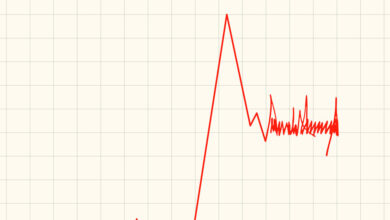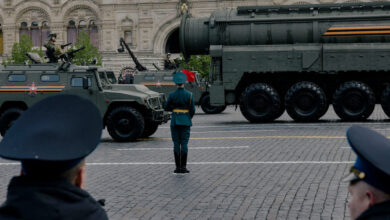Russia Is Increasingly Blocking Ukraine’s Starlink Service

Just before Russian troops pushed across the Ukrainian northern border this month, members of Ukraine’s 92nd Assault Brigade lost a vital resource. Starlink satellite internet service, which soldiers use to communicate, collect intelligence and conduct drone attacks, had slowed to a crawl.
Operated by Elon Musk’s SpaceX, Starlink has been critical to the Ukrainian military since the earliest days of the war with Russia. Without the full service, Ukrainian soldiers said, they couldn’t quickly communicate and share information about the surprise onslaught and resorted to sending text messages. Their experiences were repeated across the new northern front line, according to Ukrainian soldiers, officials and electronics warfare experts.
At the heart of the outages: increased interference from Russia.
As Russian troops made gains this month near Kharkiv, Ukraine’s second-largest city, they deployed stronger electronic weapons and more sophisticated tools to degrade Starlink service, Ukrainian officials said. The advances pose a major threat to Ukraine, which has often managed to outmaneuver the Russian military with the help of frontline connectivity and other technology, but has been on the defensive against the renewed Russian advance.
The new outages appeared to be the first time the Russians have caused widespread disruptions of Starlink. If they continue to succeed, it could mark a tactical shift in the conflict, highlighting Ukraine’s vulnerability and dependence on the service provided by Mr. Musk’s company. As the United States and other governments work with SpaceX, the disruptions raise broader questions about Starlink’s reliability against a technically sophisticated adversary.
Starlink works by beaming an internet connection down from satellites revolving around Earth. The signals are received on the ground by pizza-box-size terminal dishes, which then distribute the connection like a Wi-Fi router to laptops, phones and other devices nearby. Starlink has provided Ukraine with vital internet service since 2022, with soldiers relying on it to guide internet-connected drones that are used for surveillance and as weapons, among other tasks.
In an interview this week, Mykhailo Fedorov, Ukraine’s digital minister, said Russia’s recent attacks against Starlink appeared to use new and more advanced technology. The service previously held up remarkably well against interference on battlefields, where there has been widespread electronic warfare, radio jamming and other communication disruptions.
But the Russians are now “testing different mechanisms to disrupt the quality of Starlink connections because it’s so important for us,” Mr. Fedorov said, without giving details about what he called their “powerful” electronic weapons systems. Ukraine was constantly communicating with SpaceX to resolve the problems, he added.
SpaceX did not respond to requests for comment.
Russia’s Ministry of Defense did not respond to a request for comment. An official who leads Russia’s electronic warfare efforts told state media last month that the military had put Starlink on a “list of targets” and developed capabilities to counter the service.
While Mr. Fedorov said Starlink service should improve soon, some of the outages appeared timed to Russian attacks, according to soldiers and officials. Any disruptions at critical battlefield moments put Ukraine’s already stretched army at a further disadvantage, they said.
“We’re losing the electronic warfare fight,” said Ajax, the call sign for the deputy commander of the 92nd’s Achilles strike drone battalion, who in an interview described the challenges his troops faced after Starlink connectivity failed.
“One day before the attacks, it just shut down,” said Ajax, who would be quoted only on the condition of being named by his call sign, in keeping with Ukrainian military policy. “It became super, super slow.”
The disruptions put the entire unit at a disadvantage, said a drone pilot who goes by the call sign Kartel. During the first armored attacks of the Russian offensive this month, he said, he was in a garage without food or a sleeping bag. His team began to launch drone attacks but was hindered by the connection issues with Starlink. Communicating became so slow that soldiers had to use text messages sent across chat apps, he said — and even then it took a while for the messages to send.
“During the first hours the front line was very dynamic. The enemy was moving. And we were moving as well,” he said. “We needed to be fast in communicating.”
Over three days, he said, the unit held off the Russians, but not without difficulties. “It made everything more complicated,” he said. “Everything was more time consuming.”
Kari A. Bingen, a former U.S. Defense Department official and an expert on electronic warfare, said Starlink and other satellite communications could be disrupted by the use of a high-power radio frequency to overwhelm the connection links. The invisible attacks are typically done from a vehicle with a large radio tower attached to the top, she said.
“It’s naturally in the cross hairs of Russian forces,” said Ms. Bingen, now the director of the aerospace security project at the Center for Strategic and International Studies, a think tank in Washington. “It degrades Ukrainian forces from being able to communicate on the battlefield.”
Explanations for Starlink outages in Ukraine over the past year vary. Several experts said Russia had gotten better at interfering with the signal between the satellites and Starlink terminals on the ground by using powerful and precise jammers. Others suggested that the service had been disrupted by specialized electronic weapons mounted on drones, which can confuse Starlink’s GPS signals, the global positioning system that is used to help locate satellites.
Sharp increases in Starlink use can also degrade service. In some instances, technical restrictions intended to keep Russian forces from using Starlink have hurt service for Ukrainian soldiers along the front line. At other times, disruptions can be more random, such as earlier this month when SpaceX reported service problems worldwide because of solar storms.
Throughout the conflict, Ukrainian forces have tried various techniques to shield Starlink from attacks, including placing the terminals in holes dug in the ground and putting metal mesh over them. Infozahyst, a Ukrainian company that works with the military and specializes in building tools for electronic warfare, said it did not believe such improvised solutions were effective.
Starlink has given Mr. Musk outsize influence in the war because he controls where the satellite service is available and can choose to cut off access. In some instances, Ukrainian officials have appealed directly to Mr. Musk to turn on Starlink access during military operations so they can conduct drone strikes across enemy lines — requests that the billionaire has not always approved. The U.S. government, which has purchased Starlink terminals for Ukraine, has sometimes gotten involved in the negotiations.
Starlink is not sold directly to Russia. But this year, Ukrainian officials publicly raised alarms that Russia was using Starlink terminals bought from third-party vendors, potentially eroding Ukraine’s connectivity advantage.
Experts have warned that Ukraine is overly dependent on a single company for such a vital resource, particularly one run by someone as unpredictable as Mr. Musk. But Ukraine’s reliance on Starlink is unlikely to shrink. Few alternatives exist for such comprehensive and reliable service.
Mr. Fedorov said the Ukrainian government was constantly testing new systems. The military has specialized systems for maritime drones that have destroyed a number of Russian ships in the Black Sea, he said.
“But of course there is no mass-produced equivalent,” he said.
For Ajax, the Ukrainian commander, the loss of Starlink service brought back bad memories from the war. When he fought near the Russian border in 2022, his unit was sometimes cut off from Starlink, disrupting drone video feeds that were used for targeting artillery from a distance. In its place, the unit deployed soldiers to covertly watch enemy positions and direct attacks.
“It became the old way with radios,” he said. “We had to say, ‘Move left 100 foot.’ It was super strange.”
Andrew E. Kramer contributed reporting from Kyiv, Ukraine, and Olha Kotiuzhanska from Kharkiv and Kramatorsk.



